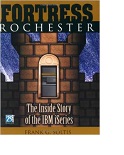I tend to get into discussions about computer processor instruction-set architecture (ISA) design. ISA design is far from my day job, but it is an interesting topic where everyone working with computers at the machine level have opinions. Typically based on a mix of personal experience and fond memories of particular machines. This in turn leads to intricate and intriguing arguments. In this blog, I will talk about my take on the current state of instruction sets in industry and the age-old “complexity of instruction set” question.
Continue reading “Useful Instruction Set Computing”Tag: power architecture
Hardware debug and measurement in the IBM POWER8

I have read some recent IBM articles about the POWER8 processor and its hardware debug and trace facilities. They are very impressive, and quite interesting to compare to what is usually found in the embedded world. Instead of being designed to help with software debug, it seems the hardware mechanisms in the Power8 are rather focused on silicon bringup and performance analysis and verification in IBM’s own labs. As well as supporting virtual machines and JIT-based systems!
Continue reading “Hardware debug and measurement in the IBM POWER8”
Fortress Rochester

In a dusty bookshelf at work I found an ancient tome of wisdom, long abandoned by its previous owner. I was pointed to it by a fellow explorer of the dark arts of computer system design as something that you really should read. The book was “Fortress Rochester”, written by Frank Soltis, and published in 2001.
Does ISA Matter for Performance?
 When I grew up with computers, the big RISC vs CISC debate was raging. At the time, in the late 1980s, it did indeed seem that RISC was inherently superior to CISC. SPARCs, MIPS, and Alpha all outpaced boring old x86, VAX and 68000 processors. This turned out to be a historical parenthesis, as the Pentium Pro from Intel showed how RISC-style performance could be mated to a CISC ISA. However, maybe ISAs still do matter.
When I grew up with computers, the big RISC vs CISC debate was raging. At the time, in the late 1980s, it did indeed seem that RISC was inherently superior to CISC. SPARCs, MIPS, and Alpha all outpaced boring old x86, VAX and 68000 processors. This turned out to be a historical parenthesis, as the Pentium Pro from Intel showed how RISC-style performance could be mated to a CISC ISA. However, maybe ISAs still do matter.
Memory Models: x86 is TSO, TSO is Good
![]() By chance, I got to attend a day at the UPMARC Summer School with a very enjoyable talk by Francesco Zappa Nardelli from INRIA. He described his work (along with others) on understanding and modeling multiprocessor memory models. It is a very complex subject, but he managed to explain it very well.
By chance, I got to attend a day at the UPMARC Summer School with a very enjoyable talk by Francesco Zappa Nardelli from INRIA. He described his work (along with others) on understanding and modeling multiprocessor memory models. It is a very complex subject, but he managed to explain it very well.
Power Architecture Rip Van Winkle
For some reason (I guess it is the job…) I was browsing through the Power ISA version 2.06 specification last week and hit the following gem of an instruction: “rvwinkle“. It is named after a short story I had never heard about, but which apparently is sufficiently well-known in the US literary canon to warrant a sleep mode being named after it.
Continue reading “Power Architecture Rip Van Winkle”
Shaking a Linux Device Driver on a Virtual Platform
 To continue from last week’s post about my Linux device driver and hardware teaching setup in Simics, here is a lesson I learnt this week when doing some performance analysis based on various hardware speeds.
To continue from last week’s post about my Linux device driver and hardware teaching setup in Simics, here is a lesson I learnt this week when doing some performance analysis based on various hardware speeds.
Continue reading “Shaking a Linux Device Driver on a Virtual Platform”
Learning Linux Device Drivers on a Virtual PowerPC

There are times when working with virtual hardware and not real hardware feels very liberating and efficient (not to mention safe). Bringing up, modifying, and extending operating systems is one obvious such case. Recently, I have been preparing an open-source-based demonstration and education systems based on embedded PowerPC machines, and teaching myself how to do Linux device drivers in the process. This really brought out the best in virtual platform use.
Continue reading “Learning Linux Device Drivers on a Virtual PowerPC”
Power Architecture Conference slides online
 The slides from the Power Architecture Conference in München and Paris are now online (and have been for a few weeks) at the Power.org site for the event. Some interesting things there about Power Architecture in particular but also virtual platforms were an almost main theme of the show.
The slides from the Power Architecture Conference in München and Paris are now online (and have been for a few weeks) at the Power.org site for the event. Some interesting things there about Power Architecture in particular but also virtual platforms were an almost main theme of the show.
Freescale QorIQ P4080 Hybrid Simulation on YouTube(!)
 YouTube – Freescale QorIQ P4080 Hybrid Simulation is a video of a demo of the QorIQ P4080 hybrid simulation. Cool of Freescale to be publishing it like this, I think it is a very smart move!
YouTube – Freescale QorIQ P4080 Hybrid Simulation is a video of a demo of the QorIQ P4080 hybrid simulation. Cool of Freescale to be publishing it like this, I think it is a very smart move!
Updated: Here is the video inline, let’s see if this works.
Power Architecture Conference München 2008
 On Tuesday next week, I will be presenting at the Power Architecture Conference (PAC) in München, Germany. The topics will be multicore debug using virtual hardware, and the new Simics Accelerator technology. Especially Simics Accelerator is pretty interesting technology.
On Tuesday next week, I will be presenting at the Power Architecture Conference (PAC) in München, Germany. The topics will be multicore debug using virtual hardware, and the new Simics Accelerator technology. Especially Simics Accelerator is pretty interesting technology.
It is a simple idea, using multiple host cores to run a virtual platform, with fairly amazing results. Now, using a single computer we can run fairly incredible simulations that were the realm of pure fantasy just a few years ago. We also got a nice new little box to demonstrate it with, an eight-core Dell with 16 GB of RAM. With 64-bit Linux, this thing makes my Core 2 Duo laptop with 32-bit Vista look like yesteryear’s snail… And creates that giggling feeling that a really impressive new toy brings up in even the most grown up boys. Booting a 16-machine network of PowerPC boards was so fast it was not demoworthy. I think we have to up the ante to some 100 target machines to make it interesting, and I have no doubt that a combination of multithreading and idle-loop optimization will make that thing be usefully interactive from the target command lines. There are many other wild things we could try on that demo box, once it gets back from the Power Architecture Conferences tour.
David Ditzel Interview at The Register/Semicoherent Computing
![]() The Register has a few podcasts in addition to their website, and the one called “Semicoherent Computing” has turned into a very nice series of interviews with interesting people from the computer industry. I recently listened to their interview from September 2007 with David Ditzel of Transmeta fame. He had a lot to say about the history of computing, as well as interesting things on where computing is going. Well worth a listen! Particular interesting highlights…
The Register has a few podcasts in addition to their website, and the one called “Semicoherent Computing” has turned into a very nice series of interviews with interesting people from the computer industry. I recently listened to their interview from September 2007 with David Ditzel of Transmeta fame. He had a lot to say about the history of computing, as well as interesting things on where computing is going. Well worth a listen! Particular interesting highlights…
Continue reading “David Ditzel Interview at The Register/Semicoherent Computing”
Power Architecture Newsletter Article
 Power.org publishes a quarterly newsletter over at www.power.org/news/newsletter. In the April 2008 issue it features a short article by me introducing Simics 4.0 and Simics Accelerator, the way in which Virtutech Simics takes advantage of multicore processors to simulate large target systems using a multithreaded simulator.
Power.org publishes a quarterly newsletter over at www.power.org/news/newsletter. In the April 2008 issue it features a short article by me introducing Simics 4.0 and Simics Accelerator, the way in which Virtutech Simics takes advantage of multicore processors to simulate large target systems using a multithreaded simulator.
IBM z6: Multicore, Accelerators
Solaris to IBM, x86 to Apple, Power to Microsoft, and other flying pig events
The register report “IBM embraces – wtf – Sun’s Solaris across x86 server line” is a very appropriate headline for something quite surprising. The day before this happened, we discussed the announced announcement and said “nah, it can’t be about operating systems”. The idea of IBM in-sourcing Solaris for x86 just felt like the kind of thing that was in the same realm as flying pigs, freezing hells, and similar unlikely events.
Continue reading “Solaris to IBM, x86 to Apple, Power to Microsoft, and other flying pig events”
